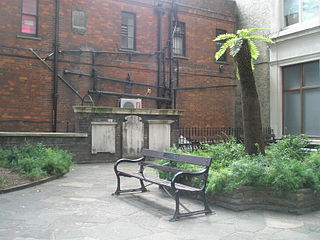Related Research Articles
Sir Richard Gardiner was, in 1478, elected Lord Mayor of London. He was Alderman of Walbrook Ward, and had been Sheriff of the City of London in 1469. He was also elected in 1478 a Member of Parliament for the City of London, one of the two aldermanic representatives of the city.
This article contains a list of the known knights of the shire who represented Buckinghamshire in the Parliament of England and similar bodies of lesser status between 1290 and 1660. It also includes details of Parliaments from 1265 to which elected knights of the shires were summoned.

The King's Wardrobe, together with the Chamber, made up the personal part of medieval English government known as the King's household. Originally the room where the king's clothes, armour, and treasure were stored, the term was expanded to describe both its contents and the department of clerks who ran it. Early in the reign of Henry III the Wardrobe emerged out of the fragmentation of the Curia Regis to become the chief administrative and accounting department of the Household. The Wardrobe received regular block grants from the Exchequer for much of its history; in addition, however, the wardrobe treasure of gold and jewels enabled the king to make secret and rapid payments to fund his diplomatic and military operations, and for a time, in the 13th-14th centuries, it eclipsed the Exchequer as the chief spending department of central government.

Sir Edmund Shaa or Shaw was a London goldsmith, Sheriff of London in 1475 and Lord Mayor of London in 1482. Shaa lent money to Edward IV and, as mayor, was extensively involved in the coronation of Edward IV's brother Richard III. He was later knighted and made a member of the Privy Council.

Farringdon Within is one of the 25 wards of the City of London, the historic and financial centre of London, England. It was formed in the 14th century from the sub-division of the pre-existing Farringdon Ward into Farringdon Within, and Farringdon Without, beyond the Wall.
The constituency of Gloucestershire was a UK Parliamentary constituency. After it was abolished under the 1832 Electoral Reform Act, two new constituencies, West Gloucestershire and East Gloucestershire, were created.

St Peter, Westcheap, also called "St Peter Cheap", "St Peter at the Cross in Cheap", or "Ecclesia S. Petri de Wodestreet", was a parish and parish church of medieval origins in the City of London. The church stood at the south-west corner of Wood Street where it opens onto Cheapside, directly facing the old Cheapside Cross. In its heyday it was a familiar landmark where the City waits used to stand on the roof and play as the great processions went past. It was destroyed in the Great Fire of London in 1666, together with most of its surroundings, and was never rebuilt.
Ralph Crepyn was a lawyer and the first documented Town Clerk of London in 1274. His birth was about 1245, and he was well-educated for his day. He died before 1331, but the exact date is unknown.
Rose de Burford was a 14th-century merchant and business woman in the City of London, England.

Sir Martin Bowes was a very prominent and active civic dignitary of Tudor London whose career continued through the reigns of Henry VIII, Edward VI, Mary I and Elizabeth I. Born into the citizenry of York, Bowes was apprenticed in London and made his career at the Royal Mint, as a master-worker and under-treasurer, and personally implemented the debasement of English currency which became a fiscal imperative in the later reign of Henry.
Sir George Whitmore was an English merchant who was Lord Mayor of London in 1631. He supported the Royalist cause in the English Civil War.

Sir William Whitmore was an English landowner and politician who sat in the House of Commons at various times between 1621 and 1626.
Sir William Browne served as Master of the Worshipful Company of Mercers from 1507 to 1514, and as alderman, auditor, Sheriff and Lord Mayor of London. He died in office on 3 June 1514 while serving his term as Lord Mayor.
Edward of Norfolk or Edward of Brotherton, was the only son of Thomas of Brotherton, and a grandson of King Edward I of England.

Sir John de Pulteney was a major English entrepreneur and property owner, who served four times as Lord Mayor of London.
References
- ↑ https://www.british-history.ac.uk/old-new-london/vol1/pp396-416
- ↑ "Lord Mayors of the City of London from 1189" (PDF). www.citybridgetrust.gov.uk. Archived from the original (PDF) on 14 July 2014. Retrieved 14 August 2014.
- ↑ J.J. Stocken, 'The Ward of Farndone', in W.P.W. Phillimore (ed.), The London & Middlesex Notebook (Elliot Stock, London 1892), pp. 113-18, at pp.114-115 (Hathi Trust)
- ↑ "The London Goldsmiths" pg. 4
- ↑ Wheatley, Henry Benjamin, and Cunningham, Peter "London, Past and Present" pg. 31
- ↑ Birley, Derek "Sport and the Making of Britain" pg. 32
- ↑ Riley, Henry Thomas "Munimenta Gildhallae Londoniensis, Vol. 3" pp. 439 - 441
- ↑ "Chronological list of aldermen: 1222-1300". British History Online. Retrieved 6 October 2016.
- ↑ Sharpe, Reginald R. "Calendar of Letter-books Preserved Among the Archives of the City of London at the Guildhall" pg. 94
- ↑ R.R. Sharpe (ed.), Calendar of Wills Proved and Enrolled in the Court of Husting, London: Part I, 1258-1358 (London, 1889), pp. 397-98 The notes on pp 397-98 contain confusions which are corrected in a note to the will of Nicholas (1361) in the second volume.
- ↑ 'Calendar of assize rolls: Roll AA', in H.M. Chew (ed.), London Possessory Assizes: A Calendar (London, 1965), pp. 1-45, no. 120. (British History Online, accessed 2 January 2019).
- ↑ R.R. Sharpe, Calendar of Wills Proved and Enrolled in the Court of Husting, London, 1258-1688. Part II: 1358-1688 (HMSO, 1890), pp. 18-19 (Internet Archive).